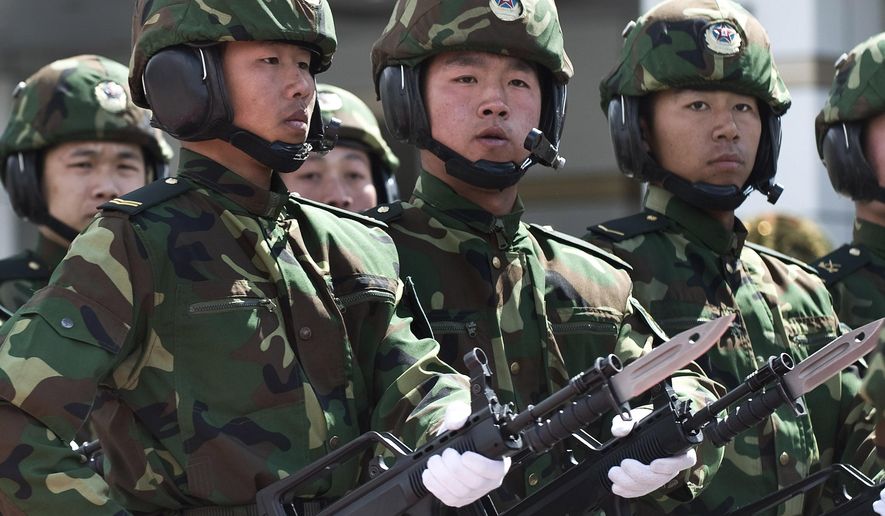At the massive Sept. 3 military parade in Beijing, Chinese President Xi Jinping — who meets President Obama in Washington as part of his state visit Friday — made a surprising announcement that the PLA would cut its troop strength by 300,000, or 13 percent, to about 2 million troops.
But the knifing will prove to be a far more daunting task for the bloated PLA, the world’s largest military force.
For the last couple of decades, China has been modernizing its military at a dizzying speed, with annual double-digit increases in the defense budget. The result has been a rapid stockpiling of some of the world’s most lethal weapons, including nuclear-tipped ballistic missiles that can hit any target in the United States, anti-carrier missiles, anti-satellite missiles, next-generation combat aircraft, and a large and highly disciplined cyber army to gather foreign military and political secrets.
But military hardware acquisition is only one part of the Chinese efforts to modernize the military. The PLA’s command and personnel structures remain antiquated, rife with inter-service rivalry, stupefying corruption and bloated bureaucracy.
As China is gearing up its combat readiness for a major military confrontation that could erupt at any time, given the growing tensions in the region, a drastic reform is being conducted in earnest to modernize the PLA organizational structure, re-align the services and trim the military bureaucracy and command headquarters, while at the same time conducting a widespread purge of senior military leaders considered loyal to the already deposed enemies of President Xi. In the last couple of years, dozens of general officers, including two of the PLA’s highest uniformed officers under Mr. Xi’s predecessor, have been purged for corruption and other unspecified crimes.
Leading the major shakeup of the PLA is Mr. Xi himself, who in early 2014 officially became the chairman of the powerful Small Leadership Group to Deepen Defense and Military Reform.
The first target of the president’s military reform is the PLA Army, which had always been the most important and politically powerful service of the PLA. Sources state that a significant portion of the army personnel to be axed will be transferred to the internal security force known as the People’s Armed Police and likely deployed to the ethnically volatile regions of Xinjiang and Tibet.
The move conforms with Mr. Xi’s steadfast insistence on strengthening the air force, navy and strategic missile command.
The highest uniformed officers within the Chinese Communist armed forces are the two vice chairmen of the Central Military Commission. Until Mr. Xi came to power, there had not been any senior officers from any service branch other than the PLA Army who had served in that position. Now, for the first time in the PLA history, an air force general and a missile commander are the two vice CMC chairmen in charge of the professional military affairs of the PLA.
While specific plans of Mr. Xi’s military reform have not been published, there have been several leaked reports of other major targets for cuts, including a large-scale downsizing of the PLA’s various non-combatant organizations, especially the Singing and Dancing Troupes at all levels of the PLA chain of command, which has become a hotbed of military corruption and sexual deviancy among senior officers. There has also been speculation about plans to slash the number of PLA’s military regional commands from seven to just four.
The PLA also runs hundreds of military schools, training specialists from military doctors and foreign language experts for the PLA’s various intelligence departments to electrical, mechanical and civil engineers, information managers and others with dual-use specialties.
Earlier this month, Mr. Xi ordered a reorganization of the biggest service academies and military schools, reducing their number from 150 to 30 and keeping only the most militarily related ones such as the PLA’s Dalian Naval Academy, Strategic Missile Academy, Military Engineering Academy. The rest — including the Chinese National Defense University, the PLA Academy of Military Sciences, and the Chinese Defense Sciences and Technology University — will all be transferred out of the uniformed services and run as civilian organizations.
All these dramatic changes have caused great uncertainty, even panic among the rank-and-file.
In April, the People’s Daily, the official mouthpiece of the Chinese Communist Party, admitted that “within the PLA, various versions of the current military restructuring have been widely circulated among colleagues and friends via short messaging texts and microblogs, making everyone excited to no end, and causing panic among our officers and soldiers.” The article warned that “a military person must regard an order from his superior as his divine duty; he must follow the order of the Communist Party, of the Central Military Commission. … He should stop talking about doing his job, he must just simply do it. Failing that, he would be no Marxist!”
But panic and paralysis persist within the PLA. In the past several weeks, top PLA leaders, including Generals Fan Changlong and Xu Qiliang, both vice chairmen of the Central Military Commission, have been visiting all regional command headquarters, calling large meetings to mobilize all unit commanders and soldiers to “follow the Party’s command” in the current mass consolidation and knifing of the PLA by their dear Supreme Leader.
• Miles Yu’s column appears Fridays. He can be reached at mmilesyu@gmail.com and @Yu_miles.
• Miles Yu can be reached at yu123@washingtontimes.com.




Please read our comment policy before commenting.